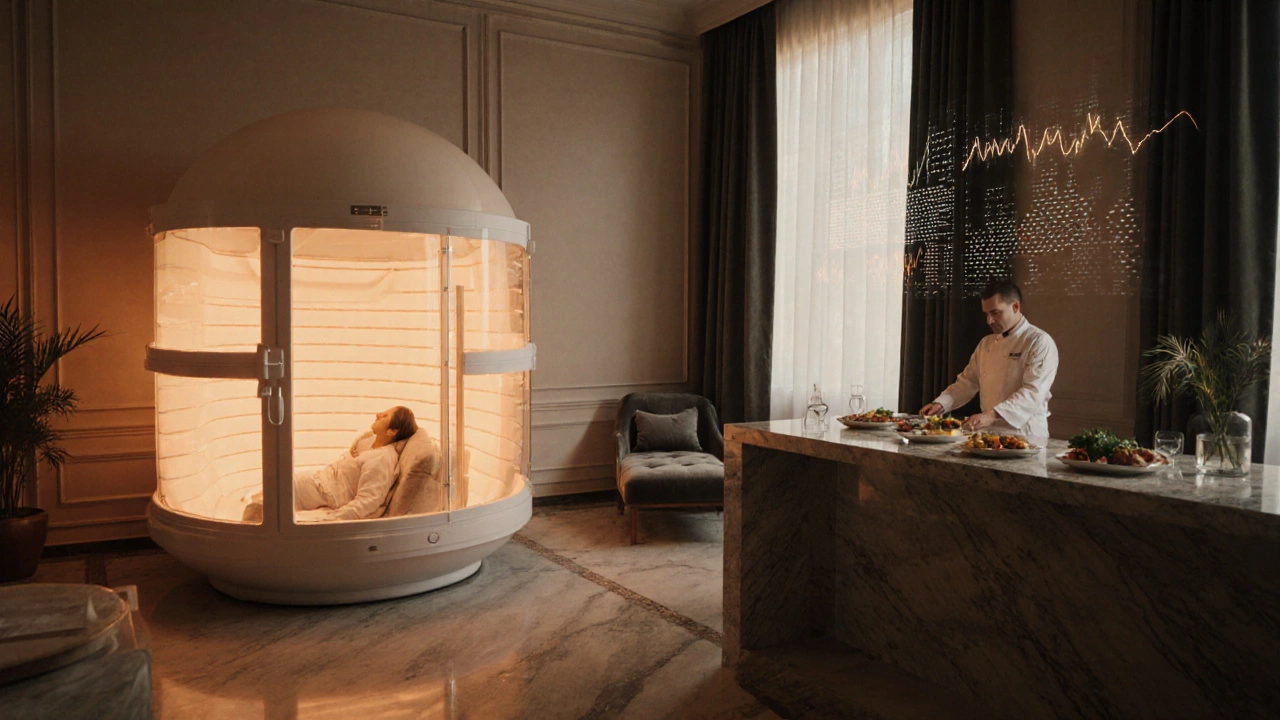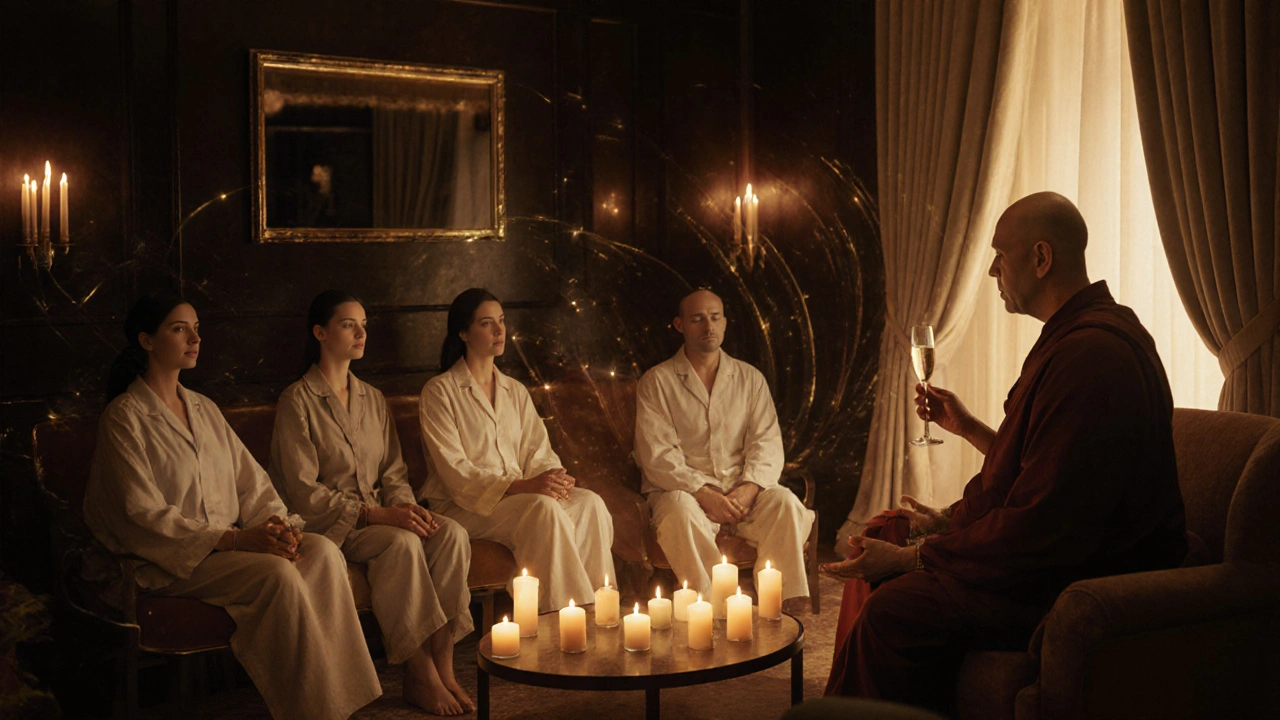
London isn’t just about historic landmarks and Michelin-starred restaurants anymore. The city’s elite are trading late-night cocktails for sunrise cryotherapy sessions and private oxygen bars tucked inside marble-clad wellness sanctuaries. If you’ve ever wondered what it’s like to belong to a club where your morning routine includes infrared sauna sessions, biometric body scans, and a nutritionist who knows your blood sugar levels by heart-this is what it looks like.
What Makes a Wellness Membership Truly Luxury?
Luxury wellness isn’t just about price tags. It’s about access, personalization, and silence. You won’t find crowded locker rooms or 15-minute appointments here. These are places where your membership includes a dedicated wellness concierge, 24/7 clinical support, and treatments designed around your DNA, sleep patterns, and stress markers. The goal isn’t to feel good for a day-it’s to optimize your biology so you perform better, recover faster, and live longer.
Take The Lanesborough Club in Knightsbridge. Their signature Biome Scan uses a non-invasive device to map your gut microbiome, hormone levels, and inflammation markers in under an hour. Your results feed into a custom plan-maybe it’s a daily probiotic blend made just for you, or a weekly IV drip with glutathione and vitamin C tailored to your stress response. No two members get the same protocol.
Top Luxury Wellness Clubs in London
The Lanesborough Club isn’t the only player. Here are three others setting the standard in 2025:
- The Sanctuary at Claridge’s - A hidden floor in the iconic hotel that doubles as a biotech spa. Members get access to a private hyperbaric chamber, a neurofeedback room that trains your brain to reduce cortisol, and a chef who prepares meals based on your genetic food sensitivities.
- One Aldwych Wellness - This is where CEOs go to reset. Their Recovery Suite includes a cold plunge pool chilled to 4°C, red light therapy beds, and a sleep pod that uses binaural beats to guide you into deep rest. Members can book a 30-minute nap between meetings-no questions asked.
- Chiltern Firehouse Wellness - A spin-off of the famous restaurant, this membership blends wellness with social exclusivity. You’ll find meditation circles led by Tibetan monks, IV therapy lounges with champagne pairings, and a weekly Cellular Rejuvenation class using pulsed electromagnetic field therapy.
Each of these clubs charges between £12,000 and £25,000 a year. But here’s what you’re really paying for: time. No waiting. No crowds. No compromises.
Elite Wellness Clinics: Where Science Meets Serenity
Clubs are for lifestyle. Clinics are for results.
The London Centre for Regenerative Medicine on Harley Street doesn’t sell memberships-they sell outcomes. Their Longevity Protocol includes monthly blood panels, telomere length tracking, and personalized peptide therapy. One member, a 52-year-old entrepreneur, saw his biological age drop from 58 to 49 in 14 months after following their program.
Dr. Tanya Khanna’s Wellness Lab is another standout. She’s a former NHS physician who left the system to build a clinic focused on hormonal balance and adrenal recovery. Her clients-mostly high-performing women in finance and tech-get weekly cortisol tests, sleep architecture analysis via wearable EEG headbands, and customized adaptogen blends. Her waitlist is 18 months long.
These aren’t spas. They’re medical-grade wellness labs with velvet couches and no waiting rooms.

What You Get Beyond the Spa Treatments
The real value isn’t in the massages or the saunas. It’s in the ecosystem.
At One Aldwych Wellness, your membership includes a personal sleep coach who monitors your Oura Ring data and adjusts your bedtime routine weekly. At The Sanctuary at Claridge’s, you get a nutritionist who flies in from Switzerland to do a 3-day gut reset with you-once a quarter.
Some clubs even offer wellness travel. Chiltern Firehouse Wellness arranges private retreats to Tuscany or the Swiss Alps, where members spend a week under the care of a team that includes a functional medicine doctor, a yoga therapist, and a mindfulness coach. Meals are prepared by a Michelin-starred chef who follows your micronutrient profile.
These aren’t add-ons. They’re core parts of the experience.
Who Are These Memberships For?
They’re not for people who want to "get healthy." They’re for people who are already healthy-and want to be exceptional.
Typical members include:
- Founders and executives managing burnout after years of 80-hour weeks
- High-net-worth individuals with family histories of heart disease or Alzheimer’s who want to intervene early
- Professional athletes and performers recovering from injury with precision tools
- Parents who want to optimize their energy to keep up with demanding kids
It’s not about vanity. It’s about longevity. One member told me, "I used to think I was too busy to sleep. Now I realize I was too busy to live."
The Cost: Is It Worth It?
Annual fees range from £12,000 to £35,000. Some clinics charge £1,500 per session for peptide therapy or IV drips. It’s expensive. But consider this:
According to a 2024 study by the Global Wellness Institute, high-net-worth individuals who engaged in personalized wellness programs reduced their annual healthcare spending by 37% over three years. They missed fewer workdays. They reported higher focus and creativity. Their sleep quality improved by an average of 62%.
That’s not just wellness. That’s ROI.
And if you’re spending £20,000 a year on private schools, a second home, or a luxury car-how much are you really investing in your own body? The one thing you can’t replace?

What to Look For Before You Join
Not all "luxury" wellness is created equal. Here’s what to ask:
- Do they use real medical-grade equipment? (Look for FDA-cleared or CE-marked devices-not just "wellness tech" gadgets.)
- Is there a licensed physician on staff? (Not just a "wellness advisor" with a yoga certification.)
- Can you see your data? (You should get access to your blood work, sleep graphs, and hormone trends through a secure portal.)
- Are treatments personalized-or just a menu of trendy services?
- What’s the refund policy? (The best ones offer a 30-day trial with no penalty.)
Red flags: No lab results, no clinical oversight, or staff who can’t explain the science behind their treatments.
The Future of Luxury Wellness in London
London is becoming the global capital for personalized health. New clinics are popping up with AI-driven diagnostics that predict disease risk before symptoms appear. One startup, VitaLabs, is testing a wearable that detects early signs of neurodegeneration through skin biomarkers-already being used by select members of The Lanesborough Club.
Expect more integration with mental health. Neurofeedback, vagus nerve stimulation, and ketamine-assisted therapy are becoming standard offerings-not just for depression, but for peak performance.
This isn’t a trend. It’s the next evolution of how the wealthy care for themselves. And it’s no longer just about looking good. It’s about being resilient, sharp, and alive-for decades longer than your peers.
How much do luxury wellness memberships in London cost?
Annual memberships at top clubs like The Lanesborough Club or One Aldwych Wellness range from £12,000 to £25,000. Premium clinics such as The London Centre for Regenerative Medicine charge additional fees for treatments-often £1,000 to £3,000 per session for advanced therapies like peptide injections or IV nutrient drips. Some offer tiered packages, with top-tier access costing up to £35,000 per year.
Are luxury wellness memberships worth the price?
For high-performing individuals, yes. A 2024 Global Wellness Institute study found that members reduced their annual healthcare spending by 37% over three years and reported significantly better sleep, focus, and energy. These memberships aren’t about luxury for luxury’s sake-they’re about preventing burnout, extending healthspan, and maintaining peak cognitive function. The ROI isn’t just financial; it’s in quality of life.
Do I need a referral to join these clubs or clinics?
Most top-tier clubs and clinics don’t require formal referrals, but they often have a vetting process. Some, like Dr. Tanya Khanna’s Wellness Lab, maintain waitlists of 12-18 months and prioritize clients with specific health goals or medical histories. Others, like The Sanctuary at Claridge’s, offer private tours and consultations before accepting new members to ensure alignment with their philosophy.
Can I try a luxury wellness membership before committing?
Yes. Many offer 7- to 30-day trial packages. The Lanesborough Club, for example, lets you book a "Wellness Discovery Day" for £1,200, which includes a full biometric scan, a personalized nutrition plan, and access to their recovery suite. Some clinics offer single-session experiences-like a $800 IV drip or a neurofeedback session-to test the service before committing to a full membership.
Are these services covered by private health insurance?
Generally, no. Most private health insurers in the UK cover only medically necessary treatments, not preventive or performance-enhancing wellness services. However, some high-end policies from providers like Bupa or AXA PPP now offer limited wellness allowances-typically up to £1,500 per year-for things like acupuncture or massage. You’ll need to pay out-of-pocket for the full luxury experience.
Next Steps: How to Get Started
If you’re serious about exploring luxury wellness in London:
- Start with a discovery session. Book a 60-minute consultation at one of the top three clubs or clinics listed above.
- Ask for your baseline data-blood work, sleep metrics, stress markers. Don’t accept vague promises.
- Compare the science behind their treatments. Look for peer-reviewed studies backing their protocols.
- Check if they offer a money-back guarantee or trial period.
- Don’t rush. The best programs are designed for the long term, not quick fixes.
Wellness isn’t a destination. It’s a daily practice. And in London, the most exclusive members aren’t just buying a membership-they’re investing in the most valuable asset they’ll ever own: themselves.